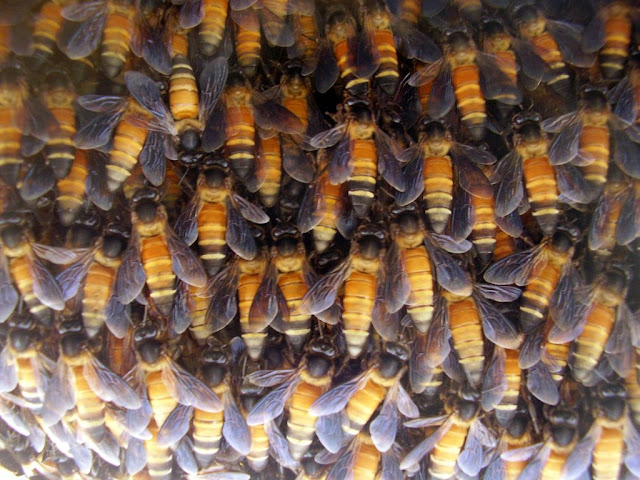Honeybee Facts Part II
Honeybee Facts Part II
Image source: "ApisDorsataHive" by Bksimonb at the English language Wikipedia. Licensed under CC BY-SA 3.0 via Commons - https://commons.wikimedia.org/wiki/File:ApisDorsataHive.jpg#/media/File:ApisDorsataHive.jpg
2. There are 3 million plus honey-producing colonies in the United States.
3. A honey bee visits between 50 and 100 flowers during one collection trip.
4. A typical healthy hive may contain up to 60,000 honey bees during peak times.
5. Honey bees make an average of 1,600 round trips in order to produce one ounce of honey.
6. Bees will travel as far as one or two miles from the hive to gather nectar.
7. Honey bees from a typical hive visit approximately 225,000 flowers per day.
8. Queen bees will lay as many as 2,000 eggs on a good day -an average of one every 45 seconds.
9. A good queen bee will lay between 175,000 and 200,000 eggs per year.
10. The average central temperature of the brood nest is kept between 92-95 degrees Fahrenheit.
11. Beeswax production in most hives is only about 1.5% to 2.0% of the honey yield.
12. Approximately eight pounds of honey is eaten by bees to produce one pound of beeswax.
13. The Americas have no native honey bees -- early pioneers first brought them from Europe.
14. Honey bees pollinate approximately 25% of all the foods humans consume.
15. Besides honey, honey bees produce wax and propolis, gather pollen, and produce royal jelly.
16. A typical foraging honey bee will work herself to death in about three weeks.
17. There are 16,000 recognized species of bees, nine of which are honey bees (genus Apis).
18. Most bee species are reclusive and solitary; however, the honeybee (Apis mellifera) is highly social. They are the species most commonly raised by people for honey and their pollination services.
19. A hive consists of three types of bees: one queen, the worker-bees (all female) and the drones (all male).
20. A queen bee will lay 1,500 eggs per day, or 225,000 per breeding season.
21. Worker-bees perform age-based tasks, from cleaning the hive to foraging for food. These bees die when they sting.
22. Drones have one task: to mate with a young queen. At the end of the season, drones are pushed out of the hive by the worker-bees. Drones do not have stingers.
23. When a bee swarm is seeking a new home, a few hundred worker bees will scout out new locations. Each bee returns to the swarm and advocates their find by dancing. The entire swarm joins the "discussion," makes a decision, and flies to the new home.
24. Bees are often confused with wasps. Wasps are carnivorous hunters and are aggressive in nature while honeybees are strict vegetarians deriving their nutrition from pollens and nectar. Honeybees are generally not attracted to food and garbage containers near barbeques and picnic sites.
25. Swarms A swarm of bees looks frightening, though bees are not aggressive at this stage in their life cycle. Bees are more docile in a swarm than when they are in a hive because they do not need to protect the hive. Swarms generally move on to their new hive within a day or two.
26. Killer Bees “Killer Bees” (Africanized Honey Bees) are much more aggressive than regular honeybees.
27. The study of honey bees is known as melittology.



Comments
Post a Comment